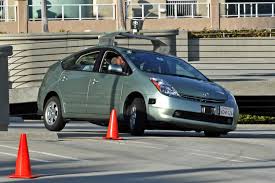Tag Archive: Self-driving cars

Self Driving Cars Weren’t At Fault In Small Number Of Crashes
May 13, 2015
Self driving cars have recorded very few crashes and, for the most part, weren’t at fault in those they did experience according to research done by the Associated Press.
While self driving cars, have been on the road for several years, the manufacturers weren’t required to publicly report crashes involving their cars until a new California law went into effect in September of 2014. That law made public reporting of crashes involving self driving cars a part of the licensing agreement to test the cars on state roads.
Google has been driving their self driving cars on California roads for six years. At all times, there are engineers behind the wheel ready to take over in case something goes wrong. According to Google, the cars have have driven more than 1.7 million miles with one million of those miles completely automatic.
According to Google, their 23 cars have been involved in eleven minor crashes with only minor damage and no injuries. Google claims that none of the cars on automatic mode were at fault in the crashes.
In April, in the first trip of its kind, Delphi Automotive sent a self driving car across the country from California to New York with 99 percent of the driving done by the car’s automatic controls. There were no reported incidents. Delphi did report one crash previous to the cross-country trip in which the driver of the other vehicle was at fault.
The promise of self driving cars is that they will make driving safer because, unlike human drivers, they follow traffic rules, obey the speed limit, and watch for hazards on the road. Even in an “unavoidable” crash, say with a red light runner, the self driving car can react quicker and apply the brakes or perform an evasive maneuver that will lessen the impact of the crash.
As of now, four states (California,Nevada, Michigan and Florida) plus the District of Columbia have passed laws authorizing testing of self driving cars on their roads. None of the other states outside of California have reported any crashes.

Could Self Driving Cars Lead To More Car Sickness?
April 20, 2015
Could self driving cars lead to more car sickness? Two researchers, Michael Sivak and Brandon Schoettle of the University of Michigan Transportation Research Institute are suggesting that self driving cars could lead to more car sickness among their riders.
Car sickness is a type of motion sickness caused by a conflict between what the eyes see and what the inner ear is experiencing. When a person is involved in an activity, say reading a book, while the car is in motion, the person’s eyes are telling the brain that he or she isn’t moving; however the signals received from the inner ear’s balance system are telling the brain something quite different. The conflict between these two signals can lead to sickness; most often nausea and vomiting.
That’s why car sickness is most often seen among young children sitting in the back seat of the vehicle. They’re often too small to see out the window and they’re normally involved in other activities such as coloring or reading a book. Their eyes aren’t receiving those signals telling them that they’re in motion but their inner ears are. Many a parent has experienced the frustration of a child, suddenly and with little warning, vomiting all over the back seat. It doesn’t make for a pleasant family trip.
The U-M researchers surveyed 3,200 adults in the U.S. and five other countries and asked what kind of activities they would engage in if they were freed of the responsibility of driving in a self driving vehicle. More than a third said they would engage in activities such as reading, playing a game, or watching a video. Those are just the types of activities that could potentially lead to car sickness.
Without looking at the road and matching the eye’s signals to the signals coming from the inner ear, the researchers predict that anywhere from six to twelve percent of adults could be expected to suffer the effects of car sickness.
Health experts advise that, to prevent car sickness, riders should look out the window and gaze toward the horizon in the direction of travel; doing that will stop that sensory conflict that causes car sickness. For children, along with the obvious safety benefits, another benefit of booster seats is that they help raise the child up to a height where they can more easily look out the window and, hopefully, limit the effects of car sickness.
Read more: Motion sickness in autonomous cars: Don’t read and ride
